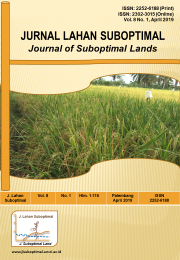Penggunaan Melati Air (Echinodorus palaefolius) sebagai Filter Biologi pada Pemeliharaan Ikan Maanvis (Pterophyllum scalare)
DOI:
https://doi.org/10.33230/JLSO.8.1.2019.388Keywords:
angelfish, Biological filter, Water jasmine, Water qualityAbstract
Riyadhi et al, 2019. The Using of Water Jasmine (Echinodorus palaefolius) as Biological Filter on Angelfish (Pterophyllum scalare) Rearing. JLSO 8(1):67-76.Â
Water quality was one factors that become a contraint in ornamentalfish culture. This study aimed to compare the result of jasmine water as a biological filter in maintaining water quality and reducing organic matter in the rearing of angelfish with a recirculation system. This research was conducted for 28 days at the Basic Laboratory of Aquaculture, Departement of aquaculture, Universitas Sriwijaya. The research Used a completely randomized design with 5 treatments and 3 replications. The results showed that water quality of the temperature, pH, dissolved oxygen, ammonia, nitrat and  phosphate values was (27.2-29.2ºC), (5.7-6.9), (4.68-5.74 mgL-1), (0.005-0.037 mgL-1), (0,06-0,12 mgL-1) and ( 0.013-0.107 mgL-1). In treatment P0 the lowest fish survival was 44.45%, absolute length growth was 1.56 ± 0.26 cm, absolute weight growth was 1.47 ± 0.34 g, feed efficiency was 40,54 ± 2,54. While in treatment P4 the highest survival was 72.22%, absolute length growth was 1.24 ± 0.17, absolute weight growth was 1.25 ± 0.24 g feed efficiency 51.32 ± 13. The survival rate of angelfish in the treatment without using water jasmine showed the lowest percentage of survival compared to other treatment.
Downloads
Additional Files
Published
2019-01-17
How to Cite
Riyadhi, K. A., Jubaedah, D., & Wijayanti, M. (2019). Penggunaan Melati Air (Echinodorus palaefolius) sebagai Filter Biologi pada Pemeliharaan Ikan Maanvis (Pterophyllum scalare). Jurnal Lahan Suboptimal : Journal of Suboptimal Lands, 8(1), 67–76. https://doi.org/10.33230/JLSO.8.1.2019.388
Issue
Section
Articles
License
Copyright (c) 2019 Kezia Agustine Riyadhi, Dade Jubaedah, Marini Wijayanti

This work is licensed under a Creative Commons Attribution-NonCommercial-ShareAlike 4.0 International License.













